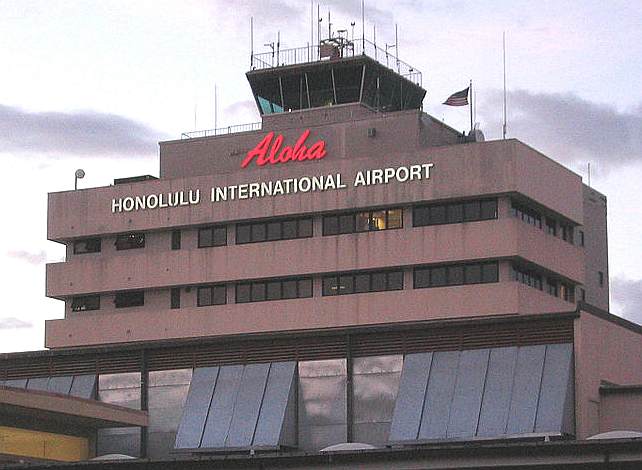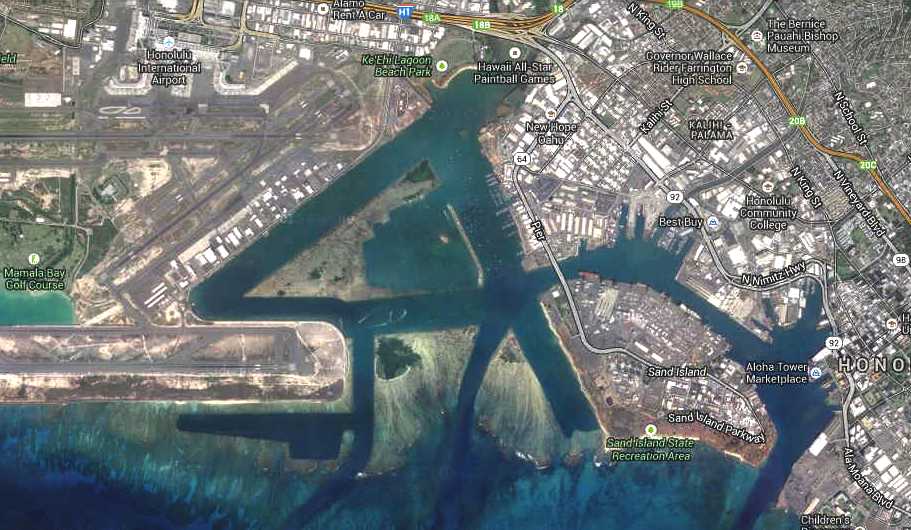|
|
HONOLULU HARBOR
|
|
|||||||||||||||||||||||||||||||||||||||||||||||||||||||||||||||||||||||||||||||||||||||||||||||||||||||||||||||||||||||||||||||||||||||||||
|
Honolulu Harbor, also called Kulolia and Ke Awa O Kou, is the principal seaport of Honolulu and the State of Hawaii in the
United
States.
Map of Honolulu - International Airport left and Sand Island right
SAND ISLAND
Sand Island is a small island within the city of Honolulu, Hawaii, United States. The island lies at the entrance to Honolulu Harbor.
Chapter 13 - SOLAR RACE 200 N, 1600 W Honolulu Harbor, Hawaii SAND
ISLAND – HONOLULU HARBOUR 7:00 am “This
is the Captain. Will all passengers please fasten your seat belts. We are
beginning our decent….and remain seated until the seat belt warning
signs go out. Thank you.” The
familiar white lights came on immediately. Steve
Green and Charley Temple were already buckled up, and looked at each
others belt, then nodded to each other and smiled. They had been looking
forward to this assignment for at least two years; a pollution free event
of epic proportions – the first ever international World Solar Challenge
for boats. The ‘Green Team’ as they were now known, had invested
considerably in this world first. Steve had chartered a long-range
Sea-King helicopter for a week from Pacific Wings, in the hope of getting
superior aerial photographs of the boats and the Hawaiian Islands
archipelago. Single engine aircraft, including helicopters were forbidden
from flying below 500 feet near Hawaii due to a spate of accidents years
back. If it’s not possible to get close, then reporters could at least
improve the odds of a decent shot, by being able to hover; fuel intensive,
though that would be. The
Qantas United, Boeing Ecobird, banked right while losing altitude fast
into a perfect ten degree approach to Honolulu International Airport.
There was some buffeting from turbulence as the aircraft cleaved through
layers of air at different temperatures and densities. The Ecobird was a
highly advanced plane in it’s time, a fuel efficient marvel, but was
showing her age. It was introduced in the years after 2015, when dozens of
airlines were bankrupted as cleaner burning fuel-oil prices rocketed and
banks and the stock markets worldwide suffered near collapsed from a mix
of lack of borrowing and wild speculation, causing a serious economic
depression. Flaps
were deployed to slow the aircraft and undercarriage whine could be heard
as electric motors pumped hydraulic fluid at 2000 pounds per square inch
to powerful piston actuators to lower the wheel assembly’s. They then
thudded onto the runway suddenly screeching followed by a soft rumble as
the wheels burned rubber accelerating from a standstill to well over 3000
revolutions per minute and the engines screamed back to full revolutions
to provide reverse thrust for additional braking. The
Green Team had arrived three days earlier than the official start of
activities, planning to interview contestants and island officials. Steve
and Charley disembarked from the Ecobird at terminal two, to the west of
Sand Island, after an uneventful passage. From
there it was just three miles to Sand Island. For many years a group of
like minded conservationists and sailors had dreamed of organising
something spectacular, and what better than a race around the world, first
proposed in 1995 by an English inventor as the ultimate test for any
sailor. Steve had agreed they’d camp with a group of enthusiastic
supporters, rather than hotel it – as a nice gesture in the spirit of
environmentalism. Being
prepared like this was quite an event in itself. Reporters didn’t have
such luxuries as time to prepare, so it felt almost like a holiday. “Okay
then, let’s get cracking,” said Steve. He
grabbed their distinctive bags from the carousel and heading off to
customs with a trolley, where their reporter’s tags saw them outside
hailing a minicab in minutes. Casting
his mind back, Steve remembered when solar sports consisted of cars that
were little more than a row of off-the-shelf solar panels, stretched
between bicycle wheels by hippies on pocket money budgets. Soon, these
became low gleaming streamlined carbon fibre teardrops on finely machined
alloy rims, driven by university undergraduates, financed by big business. Racing
solar vehicles competitively began in the 1980’s with an astonishing
3000 miles course across the Stuart Highway and miles of unmade desert
roads from Darwin in the North to Adelaide on the southern coast of Australia. Contestants battled sand storms and road trains (Australian
trucks pulling several trailers) and each other, for the World Solar Cup
– a somewhat misleading title, that many purists thought should be
renamed the Australian Solar Cup. In
subsequent years solar car racing became popular with engineering students
the world over, attracting generous sponsorship deals from high street
names like Panasonic, Fuji, Hitachi, General Motors and Honda. With such
an enthusiastic take up on this continent, other countries introduced
their own version of the race, including Canada and the
United
States. Boating
enthusiasts soon decided to get in on the act, applying solar energy to
water craft by literally strapping rigid panels to canoes. Competition
events were local affairs to begin with, the most famous being in
Amsterdam. Soon there were leisurely solar river cruises in Switzerland
then Scotland, and island cruises in the South Seas, Indonesia and the Caribbean. Then in May of 2012 the first pure solar powered
circumnavigation was completed by a boat converted from a sea going ferry
design called PlanetSolar. “Daydreaming
again Steve,” said Charley. “You got me; it’s just that I can’t believe it’s finally come true.”
- * -
LINKS & REFERENCE
http://en.wikipedia.org/wiki/Honolulu http://en.wikipedia.org/wiki/Honolulu_Harbor http://www.asdwire.com/press-release-8988/ http://www.maritimeaustralia.com.au/ http://www.pacific2013.com.au/innovation-awards/index.html Kestrel Marine's Sentient object recognition system tattoos fansshare.com sectasaur_antarctic_melt_john_storm_adventure_book_by_jameson_hunter
|
|||||||||||||||||||||||||||||||||||||||||||||||||||||||||||||||||||||||||||||||||||||||||||||||||||||||||||||||||||||||||||||||||||||||||||||
|
This website is Copyright © 2018 Bluebird Marine Systems Limited. The names Bluebird, Bluefish, Blueplanet Ecostar BE3™, Utopia Tristar™ and the blue bird and fish n flight logo are trademarks. All other trademarks are hereby acknowledged.
|
|||||||||||||||||||||||||||||||||||||||||||||||||||||||||||||||||||||||||||||||||||||||||||||||||||||||||||||||||||||||||||||||||||||||||||||

